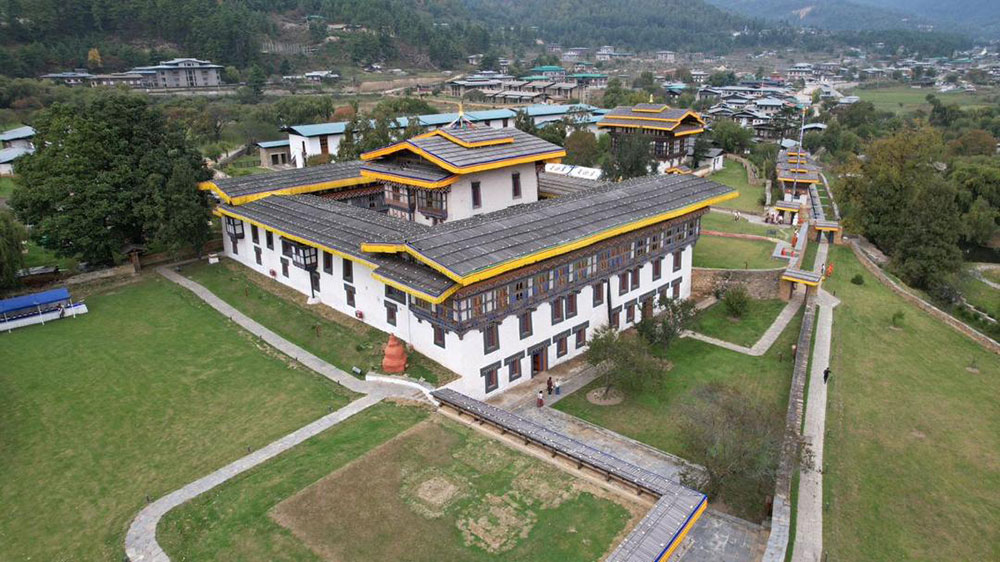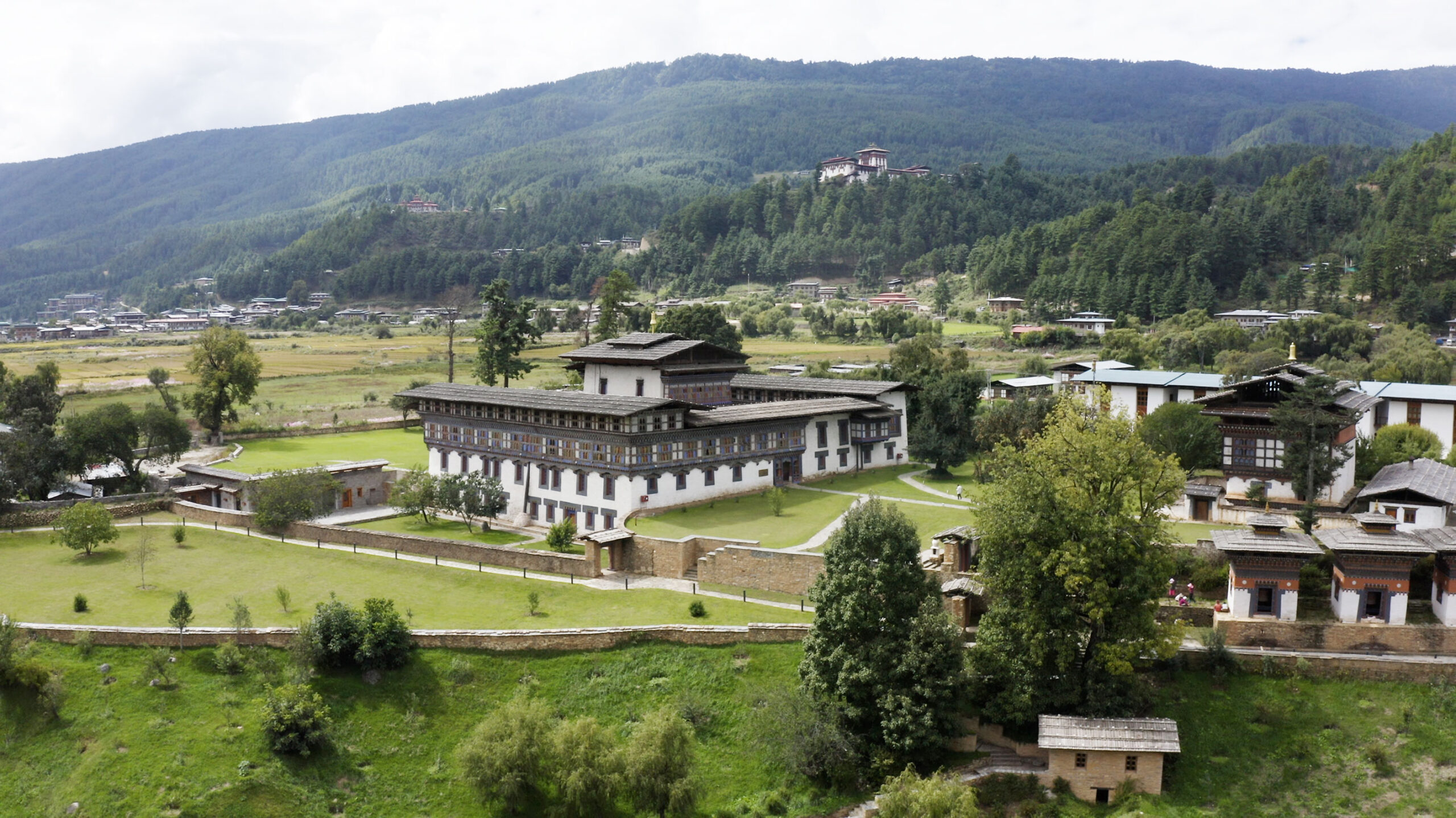The restoration of the Wangduechholing Palace in Bumthang as a museum and cultural centre is an inspiring response to the needs of the times. As a museum, it preserves an important period of history, and as a cultural centre, it can reinforce the focus on the originality of Bhutan’s sacred and artistic traditions.
Bumthang is sometimes described as the heart of Bhutanese history and culture. The vibrant landmarks of this central valley of Bhutan are Songtsen Gambo’s Jambay Lhakhang (seventh century), Guru Rinpoche’s physical imprints and blessings (eighth century), the abode of Pema Lingpa (15th century), and numerous sacred festivals, stories, and sites. These are all living institutions today. In the 20th century, Bumthang was the summer seat of the Wangchuck Dynasty.
Besides being a revered pilgrimage destination for Buddhists, the establishment of an airport, improved national highway, and the pride of Bumthaps in their distinct culture of woolen textiles and buckwheat cuisine make Bumthang a global tourism hotspot. Defined by a gently undulating terrain and rich ecology, this part of the country represents human habitat in its most pristine surroundings.

Wangduechholing, established by Jigme Namgyel, the father of Bhutan’s first King, was home to three Kings. The structure and layout of this palace and grounds tell us how the Royal family lived and played as they ruled the kingdom: a lhakhang from where spiritual guardians watched over the land and people; an elaborate line of five chhukhor mani (water-driven prayer wheels); a pear tree whose first fruit of the season is still offered to the Royal family; and the inevitable archery range where Bhutan’s legendary archers establish their reputations. A number of senior citizens, now in their 70s and older, remember playing on these grounds as children, sometimes watched by His Majesty from an upstairs window. The atmosphere of the annual festival and a much-anticipated feast that the palace hosted is presented as a virtual display in the museum.
If walls could talk, every room of Wangduechholing must have seen amazing stories. The museum uses new technology and the creativity of artists to tell stories of old. An interactive table-style timeline with a multi-touch screen in dual languages provides multiple layers of information on the museum. An AV gallery screens a video introduction to the palace and its architectural history. The King’s antechamber, from which the governance of the kingdom was coordinated, is recreated with furniture and objects, as well as depictions of the people of that period relating to day-to-day activities of governance.
The new face of Wangduechholing emerges at a time when our short historical memory is already fading, given the geographic distance and historical timeline. The decades are blurred after the Royal entourage left central Bhutan in the 20th century in the transition of capitals. When the Royal family moved to Punakha, and then to Thimphu, the palace was left in neglect for decades, much to the disappointment of discerning members of Bhutanese society. As Bumthang became a draw for tourists, the ruins of the palace became a backyard of a high-end resort.
Today, we applaud the invaluable restoration efforts by Bhutan’s Royal family, public servants, professionals from around the world, numerous traditional craftsmen and modern ICT specialists, and volunteers from all sections of society. Friends of Bhutan who contributed time and resources vividly remind us of the value of friendship as well as the importance of the past.
Wangduechholing’s restoration is a story in itself. While there were a number of proposals, His Majesty the King approved the restoration process of the palace into the concept visible today, initiated by Her Majesty Gyalyum Tseyring Pem Wangchuck more than 10 years ago. Bhutan Foundation raised funds and supervised the work. The Hoch family of Switzerland, close friends of His Majesty the Third King, and who remain closely attached to Bhutan, were the main contributors.
In a ceremonial launch on October 30, Her Majesty Gyalyum Tseyring Pem Wangchuck, Co-Chair of the Bhutan Foundation, handed over the completed Wangduecholing Museum and Cultural Centre to Her Majesty the Gyaltsuen, the new Royal Patron of the Museum. It will now be managed by a Board of Directors under the patronage of Her Majesty the Gyaltsuen, herself from a family connected with the Wangchuck dynasty.
This represents a direct transition of generations in the era of transformation. Like most aspects of the changing Bhutanese lifestyle, audiovisual and digital technology is used to tell the stories of Bhutan which are steeped in tradition. The restored palace and innovative displays can help preserve the essence of the Bhutanese identity, which influences the transformation of the country even today.
Museums have many roles: to preserve memories of the ancestors, and educate posterity. Bhutanese institutions have the added function of keeping the deep sense of “Bhutanese-ness” alive. We see this today…call it Gross National Happiness, call it mindfulness, call it nostalgia…many Bhutanese, and observers, are still trying to understand why thousands of Bhutanese men, women, and children break down in tears when His Majesty The King visits the Bhutanese diaspora outside the country.
The resounding message is that, as the times change, we should not forget our own origins and lose our identity.
Contributed by Dasho Kinley Dorji


